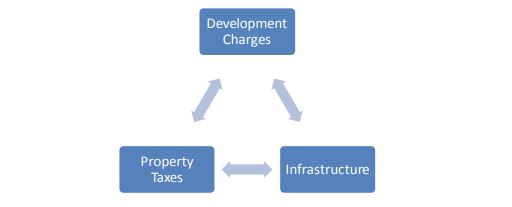Financial Matters:
Development charges are a very i mportant component of a municipality’s capital budget funding strategy. Capital projects relative to roads, sewers, libraries, community centres, etc., can be projects that aim to maintain the existing infrastructure in good condition or expand the existing infrastructure for growth related needs.
As a municipality grows, the infrastructure and public amenities also need to expand if the same level of service is to be maintained. For relatively minor growth, this may not be completely intuitive. However, everybody would immediately understand that if the City expanded from 200,000 residents to, say 400,000, In general terms, the existing infrastructure and public amenities would need to double in order for the current service levels to be maintained.
The question then becomes, who should pay the costs of the growth related capital projects, the existing taxpayers who have already paid for their share of the existing infrastructure, or the developments that are responsible for the need for the additional infrastructure required to service them? The Development Charges Act lays out the legislative rules aimed at ensuring that municipalities can recover the reasonable growth related component’s capital expenditures from the developments that cause the need for the additional capital expenditures.
If development charges are inadequate to pay for the growth related capital costs, the only alternative is to subsidize that growth by increasing the property taxes of existing taxpayers or to reduce expenditures (which then results in a degradation of service, as roads aren’t maintained as well, etc.). In reality, both of these scenarios normally play out. The 2020 Capital Budget details projects costing hundreds of millions, which are unfunded and have a significant growth component, along with the significant infrastructure required as a result of forecasted growth in the Sandwich South Planning District.
These funding choices are shown in graphical terms in the following illustration.

The amount spent on infrastructure must generally come from either development charges revenue or property taxes (or other ratepayer fees). It is clear from the illustration that failure to have adequate development charges will inevitably lead to diversion of existing property tax levy funding away from the maintenance of the existing infrastructure and amenities in order to fund the growth related projects. This will result in a worsening of the existing infrastructure deficit.
It is sometimes argued that lowering development charges will increase development, thereby increasing tax revenues, which can then be used to fund the new development requirements. As discussed earlier in the report, there is not a significant amount of evidence that lowering development charges will significantly increase development (or vice versa). However, even if it